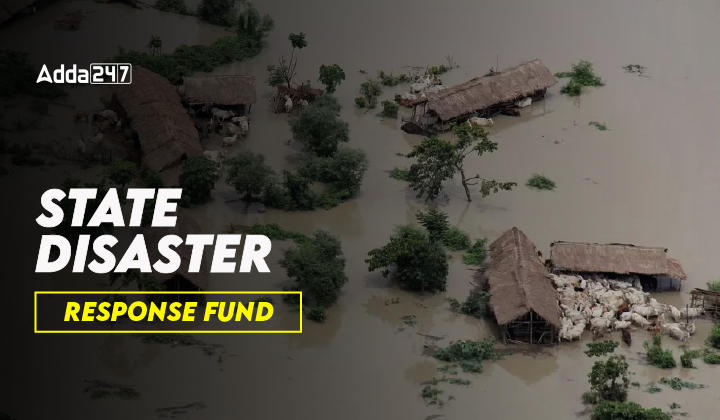Table of Contents
The State Disaster Response Fund (SDRF) serves as the principal financial resource allocated to state governments in India to address disasters within their respective jurisdictions. Understanding disaster management, including the constitution and operational aspects of SDRF, is crucial for the UPSC syllabus and is pertinent for the IAS exam.
What is SDRF Funding?
SDRF is constituted under Section 48 (1) (a) of the Disaster Management Act, 2005 it provides immediate relief funds for emergencies like floods, earthquakes, or droughts. The State Disaster Response Fund provides financial assistance to Indian states in the event of natural disasters. In the SDRF, the central government contributes the majority of funds, with special category states receiving higher allocations. It helps state governments provide food, shelter, and medical care to disaster victims.
- The central government contributes a majority of the SDRF corpus.
- The percentage varies depending on the state’s classification:
- 75% for general category states and union territories.
- 90% for special category states (North-Eastern states, Sikkim, Uttarakhand, Himachal Pradesh, and Jammu & Kashmir).
- The annual contribution is released in two instalments as per the Finance Commission’s recommendations.
Additional Points: - Up to 10% of the SDRF can be used for local disasters not included in the central list, subject to state government approval.
- The Comptroller and Auditor General of India (CAG) audits the SDRF every year.
State Disaster Response Fund UPSC: Disaster Management is one of the important parts UPSC Exam syllabus. So, it is highly suggested to learn about SDRF in this article.
Operation State Disaster Response Fund
More of a financial than an operational force is the State Disaster Response Fund, or SDRF. But in times of natural calamity, it’s indispensable for operations. This is how it’s done:
- Funding the First Responders: SDRF money is used to support the State Disaster Response Force (SDRF) – a specialized team trained for emergency response. This includes funding for equipment, training, and operational costs when deployed for disaster relief.
- Immediate Relief Measures: The SDRF allocates funds for immediate relief efforts in disaster zones. This can include food, shelter, medicine, and other necessities for the affected population.
- State-Level Disaster Management: SDRF funds are used to strengthen disaster preparedness at the state level. This includes building infrastructure for early warning systems, stocking relief supplies, and conducting community awareness programs.
- Flexibility for Local Needs: Up to 10% of the SDRF can be used for emergencies not on the national disaster list, as decided by the state government. This allows states to address local disasters specific to their region.
In short, the SDRF functions as the financial backbone for state governments to prepare for, respond to, and recover from natural disasters. It ensures critical funds are available for lifesaving operations and helps communities get back on their feet after a crisis
Types of Disaster under SDRF
The State Disaster Response Fund (SDRF) in India covers a wide range of natural disasters that can cause significant damage and hardship. Here’s a breakdown of the disaster types covered under SDRF:
- Natural Disasters: These form the core category and include events with widespread impact:
1. Cyclones: Devastating storms with high winds and torrential rain that can trigger floods and storm surges.
2. Droughts: Extended periods of below-average rainfall leading to water scarcity and crop failure.
3. Earthquakes: Sudden and violent movements of the Earth’s crust, causing ground shaking, landslides, and tsunamis.
4. Floods: Overflowing of rivers or inundation of land by heavy rain or storm surges, causing widespread destruction.
5. Tsunamis: Large, long waves generated by underwater earthquakes or volcanic eruptions. - Other Notified Disasters: In addition to the major natural disasters, SDRF also covers some specific events:
1. Hailstorms: Intense storms with large hailstones that can damage property and crops.
2. Landslides: Downward slope movement of earth and debris, often triggered by heavy rain or earthquakes.
3. Avalanches: Rapid downhill movement of snow, ice, and debris, posing a serious threat in mountainous regions.
4. Cloudbursts: Sudden, intense downpours of rain concentrated in a small area, leading to flash floods. - Local Disasters: SDRF allows some flexibility for states to address emergencies specific to their region. Up to 10% of the fund can be used for such disasters, even if they are not on the national list. This might include:
1. Pest attacks causing significant damage to crops or livelihoods.
2. Frost and cold waves with widespread negative effects on agriculture or public health.
It’s important to note that this list is not exhaustive, and new disasters can be added based on emerging threats and regional needs. The SDRF’s broad coverage ensures states have the financial resources to respond effectively to a wide range of natural disasters.
State Disaster Response Fund UPSC
The State Disaster Response Fund (SDRF) is a crucial element of India’s disaster management strategy. Understanding its role is important for the UPSC exam, particularly in the context of Governance and Disaster Management.



 TSPSC Group 1 Question Paper 2024, Downl...
TSPSC Group 1 Question Paper 2024, Downl...
 TSPSC Group 1 Answer key 2024 Out, Downl...
TSPSC Group 1 Answer key 2024 Out, Downl...
 UPSC Prelims 2024 Question Paper, Downlo...
UPSC Prelims 2024 Question Paper, Downlo...
